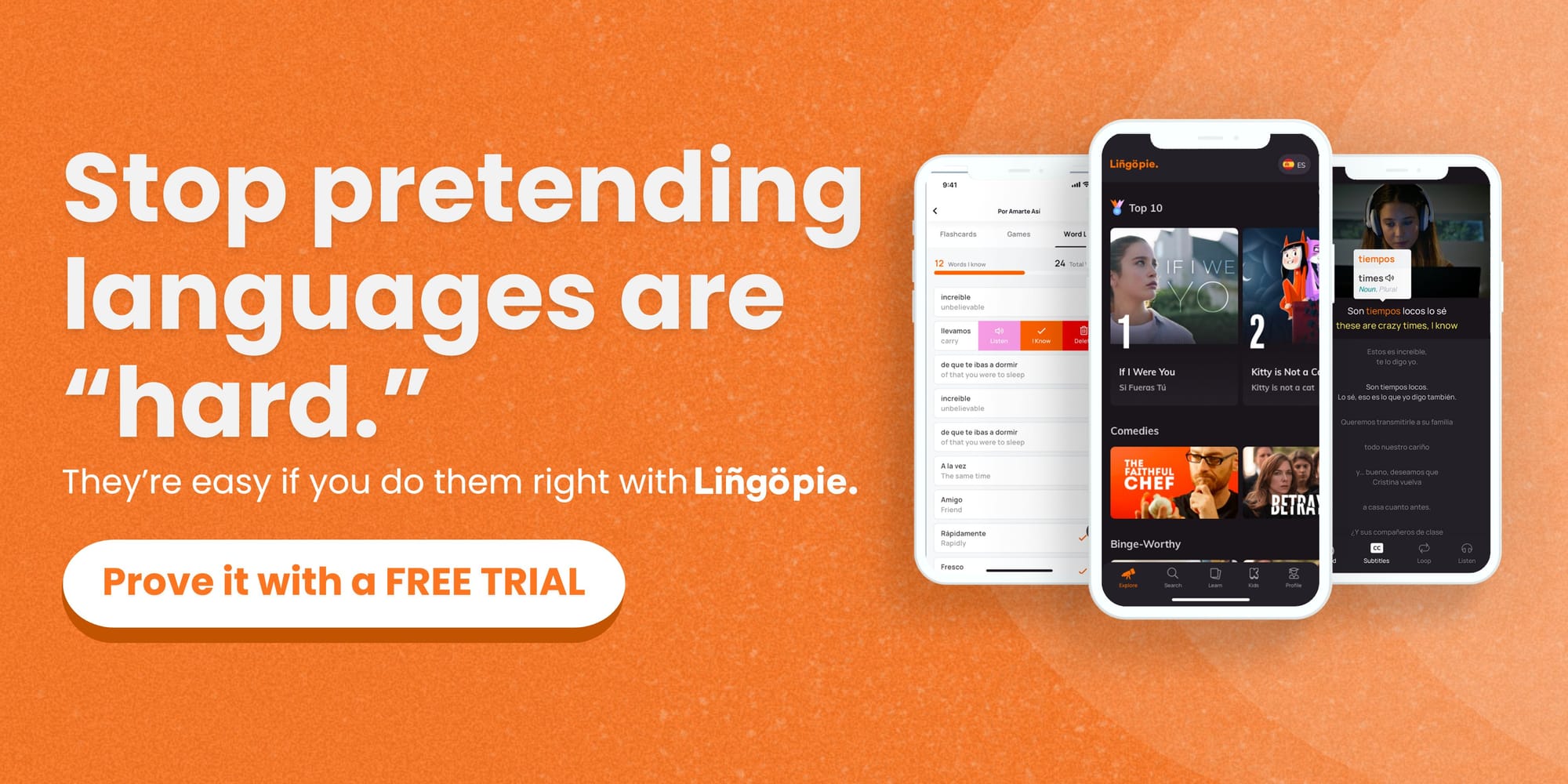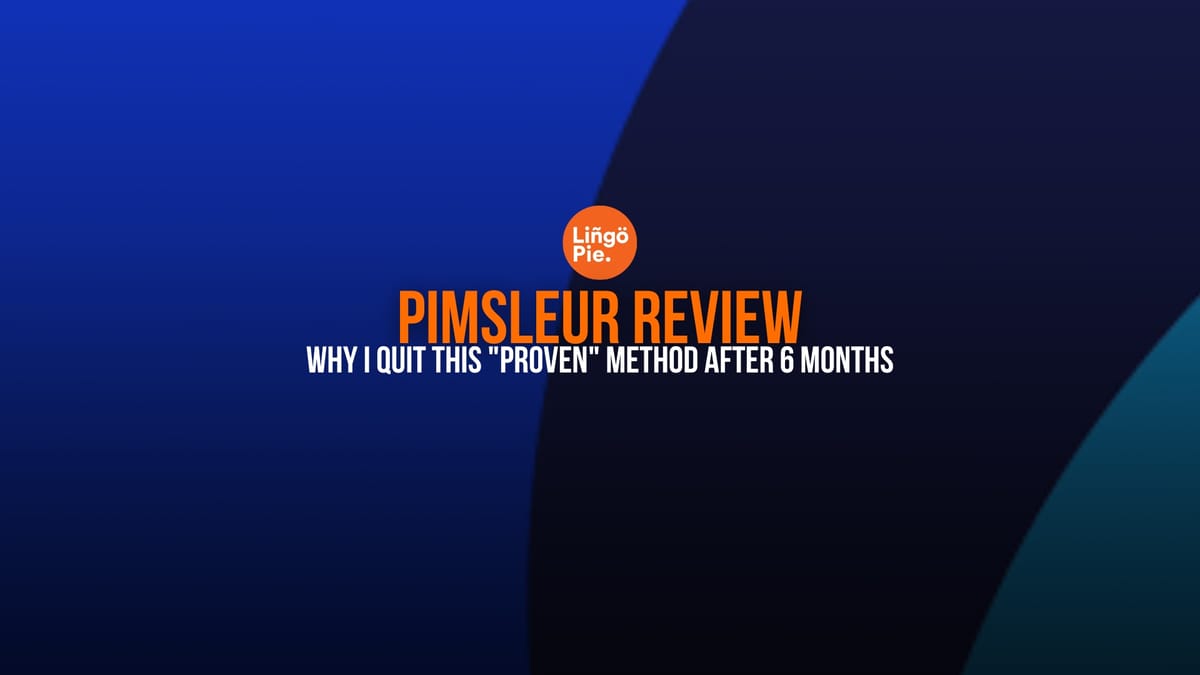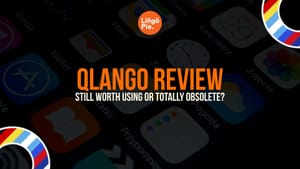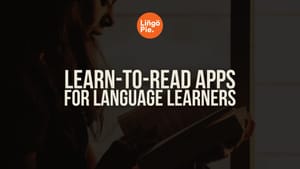Every language app out there sells the same seductive dream: download this shiny thing, follow our “proven” method, and you’ll be chatting like a local in record time. But let’s be real...the industry is saturated with overhyped promises. All those months of daily practice, fancy streaks, and gamified lessons, yet zero confidence when it matters most!
This is why, after testing dozens of these apps myself, I was skeptical when I first encountered Pimsleur’s bold claim. According to Pimsleur, audio-based learning could succeed where visual, text-heavy methods had failed. Could this controversial 30-minute daily routine actually be the missing piece in language acquisition?
To see if it holds true, I created an account to see if Pimsleur’s Spanish levels are actually worth the premium price tag or if learning through real Spanish Netflix shows would blow it out of the water. Here’s what really happened when I put both approaches head-to-head for six months, and why this method left me speechless.
- Yabla Review: Why It Didn’t Click for Me—and What Did
- WaniKani Review: I Tried This Kanji App for 30 Days—Here's What Happened
- Language Reactor Review: Why Lingopie Is The Better Choice

What Is Pimsleur?
The Pimsleur app is one of the most respected names in language learning, known for helping people develop real conversational skills, listening comprehension, and accurate pronunciation in a new language. It’s the official product published by Simon & Schuster, based on the groundbreaking research of Dr. Paul Pimsleur, a pioneer in psychology and adult second language learning in the 1960s.
Unlike the visual-heavy, grammar-drill apps everywhere today, Pimsleur is rooted in an auditory-first approach. The big idea is to acquire your new language “organically” by hearing native speakers, speaking out loud, and joining simple conversations from day one. However, I wonder how “organic” any scripted dialogue can really be, especially in complex social situations.
Personally, I find this “organic learning” concept fascinating because I know we all tend to overcomplicate foreign language learning sometimes. Pimsleur learning taps into the science of how our brains crave pattern, repetition, and real-life relevance, which is precisely what helps you respond when someone talks to you in the real world.
Pimsleur Golden Rules
When I first started to learn Spanish with Pimsleur, I was immediately prompted to the “Golden Rules” for learning.
- Always answer aloud and stay actively involved.
- Do not write anything down or look things up — trust your ears.
- Complete one lesson per day, every day. Do not jump ahead.
- Do not force memorisation. Let the repetition do the work for you.
Sounds cool, right? But here's what I think...
In my experience using the Pimsleur Spanish course, these “Golden Rules” can feel slightly limiting. For example, not writing anything down sounds great in theory because it forces you to stay focused on listening and speaking. But in practice, I craved a quick note or a visual cue to anchor expressions back to something I could see later.
The same goes for sticking to just one lesson a day. Yes, it respects how our brains absorb information gradually, but it can feel painfully slow if you are the type who likes to binge-learn when you are motivated. I have had days when I felt in the zone and wanted to knock out more, but the program basically says, “Nope, come back tomorrow.”
Another thing to consider is that, because you are not supposed to look things up, there is a limit to how much context you get. If you hit a cultural reference or idiomatic expression you do not quite get, you either let it slide or break the rules and Google it. For a detail-oriented learner, that can be frustrating!
How does Pimsleur work?

Getting started with Pimsleur is pretty simple: sign up, pick your language from their Pimsleur list of languages, and jump into lesson one. Every Pimsleur lesson follows the exact same 30-minute format, which becomes very predictable after a few sessions.
Each session kicks off with a short conversation between native speakers in your target language. An English-speaking instructor then breaks it down line by line, explaining what each phrase means and how to pronounce it. After you learn a new word or phrase, there is a pause so you can repeat it out loud. Then you hear the native speaker say it again to check yourself. This repeat-after-me cycle happens throughout the whole lesson.
Old words pop back up at spaced intervals to strengthen recall. So a word you just learned might come back after five seconds, then two minutes later, then ten minutes later — all part of the graduated interval recall. The final minutes circle back to a conversation similar to the opening dialogue, only this time, you are expected to respond naturally.

Don’t get me wrong, I like how this system reinforces memory through repetition. But honestly, I quickly hit a wall after just four lessons.
The structure, while clear, felt monotonous quickly. The audio-only format when learning Spanish with Pimsleur became a challenge for me since there are no visuals or cultural notes. Repeating the same scripted lines can feel robotic, and I wondered if I was getting better at having a real conversation or just becoming very good at reciting a script.
The difference was huge when I compared it to Lingopie, which uses authentic videos and dual subtitles. With Lingopie, I could see body language, subtitles, and cultural context, which helped connect what I heard to how people really speak. While comforting for some, Pimsleur’s predictability left me craving more variety and real-life messiness.
What are Pimsleur’s major strengths and advantages?
Despite my personal struggles with the format, I have to give credit where it's due—Pimsleur does several things exceptionally well that many other language apps completely miss. The program's reputation isn't built on hype alone; there are genuine advantages that make it stand out in the crowded language learning market.
Exceptional Pronunciation and Listening Skills Development

The program obsessively focuses on breaking down words into syllables and emphasizing proper intonation and stress patterns, which is crucial for developing authentic-sounding speech. Within just a few weeks, I noticed significant improvements in my pronunciation. Even my friends commented that my Spanish accent sounded more natural than ever before.
The Pimsleur language learning app also has a Voice Coach feature that records your speech. I personally loved that feature because it provides surprisingly accurate feedback on pronunciation, making it feel like you have a personal tutor correcting your mistakes in real-time. For anyone serious about sounding like a native speaker rather than a textbook, this focus on phonetics is invaluable.
Effective Learning Framework

The graduated interval recall system is genuinely brilliant and backed by solid memory research. Instead of cramming vocabulary and hoping it sticks, Pimsleur learning strategically reintroduces words and phrases at optimal intervals—5 seconds, then 25 seconds, then 2 minutes, and so on. This approach is designed for long-term retention, and I have to admit it works.
Words I learned in my first week were still fresh in my memory months later, which is more than I can say for most language apps. The spaced repetition feels natural and unforced, unlike flashcard apps that can feel mechanical and tedious.
Conversational Immersion and Practical Language Focus
Unlike apps that teach you random vocabulary like "the purple elephant eats cookies," Pimsleur focuses exclusively on immediately usable phrases for real-world scenarios. Every lesson starts with authentic dialogues about practical situations—ordering food, asking for directions, making small talk—then breaks them down into teachable components. This means you’re not wasting time on isolated or irrelevant vocabulary.
Active Participation and Pressure to Recall

Pimsleur constantly puts you on the spot, prompting you to respond and recall phrases under time pressure. This simulates real-life conversation scenarios where you can’t pause to think for five minutes. The active involvement prevents passive listening and strengthens memory through what they call the “Principle of Anticipation."
While this pressure sometimes felt stressful, I can’t deny that it made me more alert and engaged than apps that let you coast through lessons without really participating.
Flexibility and Convenience

The audio-based format offers genuine flexibility for busy schedules. I could practice Pimsleur Spanish lessons while commuting, exercising, or doing household chores, maximizing otherwise unproductive time. The Pimsleur app also includes a hands-free driving mode and lessons that can be downloaded for offline access. This convenience factor is a real game-changer for people with packed schedules who struggle to find dedicated study time.
Clear Structure and Guidance
The program provides a straightforward daily roadmap with clear “Golden Rules” that eliminate decision fatigue. You know exactly what to do each day—complete one lesson, don’t skip ahead, don’t take notes during the audio. For learners who prefer routine and measurable progress over choice paralysis, this structure can be genuinely motivating.
What are Pimsleur’s limitations and weaknesses?
While Pimsleur has some genuinely impressive strengths, the limitations became glaringly obvious during my six-month experiment with Pimsleur Spanish. Please do note, though, that this is only based on my experience.
Limited Input and Vocabulary Acquisition
This is probably my biggest frustration with learning Spanish with Pimsleur. The program uses scripted dialogues that feel artificial and impoverished compared to real conversations. While the dialogues are functional, they miss entirely the micro-details of how people actually talk, including interruptions, topic shifts, slang, hesitations, and the natural messiness of human communication.
More importantly, the amount of new vocabulary introduced is surprisingly limited. Pimsleur Spanish levels focus on mastering a small set of words and structures rather than expanding your lexicon, severely restricting your ability to express complex ideas or handle diverse real-life situations. After months of daily practice, I could handle the exact scenarios I’d practiced, but anything outside those narrow parameters left me speechless.
Minimal Reading and Writing Practice

Pimsleur is overwhelmingly audio-focused, and they actually instruct you not to write anything down during lessons. This completely neglects reading and writing skills, which are crucial for comprehensive language learning. The Pimsleur app does offer optional PDFs for reading practice, but they’re clearly an afterthought rather than an integrated part of the method.
For Spanish, this might be manageable since it uses familiar letters, but for languages with different alphabets or writing systems, this limitation becomes a serious challenge. You’re essentially learning to speak without learning to read—imagine trying to navigate a Spanish-speaking country without being able to read signs, menus, or text messages.
Limited Grammar Instruction
While Pimsleur language courses teach practical grammar through examples, it provide virtually no explicit grammatical rules or detailed explanations. You’re expected to absorb grammar patterns organically through repetition, but this approach confused me about why certain structures worked the way they did.
When I encountered grammar variations in real conversations, I had no framework for understanding or adapting to them. This meant I constantly needed supplemental materials for in-depth grammar study, which defeats the purpose of an "all-in-one" language program.
Repetitive and Potentially Dull Lessons
While repetition is necessary for memory retention, the predictable recycling of the same phrases and structures became mind-numbingly tedious. The Pimsleur method follows such a rigid formula that I could predict exactly what would happen in each lesson after just a few weeks.
The "decontextualized" recalls often felt like rote memorization rather than meaningful learning, and the high amount of English in early lessons was particularly frustrating when I wanted more immersion. For someone used to engaging, varied content, this monotony was motivation-killing.
Pimsleur Price

While the subscription model ($19.95 to $20.95/month) has made it more accessible than the historically "ludicrously expensive" CD sets that cost $550-$1190, it’s still pricier than popular alternatives like Babbel or Rosetta Stone. When you’re paying premium prices, you expect premium results, but the limited vocabulary and narrow focus make the cost feel unjustified compared to what you actually get.
The only good news here is that Pimsleur typically offers a 7-day free trial period for its subscriptions. Some sources also mention a 30-day money-back guarantee.

Anxiety-Provoking Elements
The constant pressure to recall material quickly can trigger foreign language anxiety and perfectionism. I got stressed during lessons, worried about making mistakes, or not responding fast enough. This anxiety actually hindered my learning progress and made the experience less enjoyable than it should have been. This pressure can be counterproductive for learners who are already nervous about speaking a new language.
Is Pimsleur sufficient as a standalone language learning resource?
Pimsleur is insufficient as a standalone language learning resource, and anyone telling you otherwise is setting you up for disappointment. While the Pimsleur method excels at teaching basic conversations and helping you start speaking from day one, it limits your vocabulary and exposure to the language.
After months of using Pimsleur for learning Spanish, I could handle maybe a dozen specific scenarios perfectly, but I lacked enough vocabulary to express anything beyond those scripted interactions. The program focuses on core vocabulary and important words, but "core" apparently means an extremely narrow set.
Most language learning experts agree that reaching fluency requires multiple methods and massive input. Pimsleur can be an excellent starting point for building speaking skills and confidence. Still, it absolutely must be supplemented with other resources that provide broader vocabulary, grammar instruction, reading practice, and authentic content.
How does Pimsleur compare to other popular language learning programs?
After testing Pimsleur alongside other popular language learning platforms, the differences become crystal clear. Each program takes a fundamentally different approach to language learning, and understanding these distinctions is crucial for choosing the right method for your goals and learning style.
Rosetta Stone vs Pimsleur

Rosetta Stone and Pimsleur are both premium language programs, but they use opposite philosophies. Rosetta Stone follows complete immersion with no English explanations, while Pimsleur uses an English moderator to guide you through lessons. Rosetta Stone is heavily visual with pictures and text, making it more suitable for visual learners, whereas Pimsleur is purely auditory.
Rosetta Stone often teaches vocabulary in isolation rather than Pimsleur's conversational context, which can make it harder to use words naturally in real situations. Both programs are structured and methodical, but Pimsleur gets you speaking from day one, while Rosetta Stone might take longer to build speaking confidence.
Pimsleur vs Lingopie

Lingopie takes a completely different approach by teaching languages through authentic TV shows, movies, and music videos in your target language. While Pimsleur uses scripted dialogues, Lingopie exposes you to how people actually speak today, complete with slang, cultural references, and natural speech patterns. Lingopie provides unlimited vocabulary through real content, whereas Pimsleur limits you to a narrow set of core vocabulary.
The main advantage of Lingopie is that you’re learning a practical, modern language while being entertained, making it much more engaging than Pimsleur’s repetitive structure. However, Lingopie requires more self-direction and might be overwhelming for absolute beginners who need the structured guidance that Pimsleur provides.
Duolingo vs Pimsleur

Duolingo and Pimsleur are practically opposites in their approach to learning a new language. While Pimsleur focuses on 30-minute audio lessons with conversational practice, Duolingo offers bite-sized, gamified lessons that rarely exceed 10 minutes. Duolingo is heavily visual with pictures, text, and multiple-choice questions, making it more engaging for visual learners, whereas Pimsleur is purely audio-based.
The biggest difference is authenticity: Pimsleur teaches you to participate in realistic conversations from day one, while Duolingo often has you translating bizarre sentences like "The owl drinks coffee." However, Duolingo teaches you to recognize and translate rather than naturally produce language, which means you might understand a lot but struggle to speak fluently in real conversations.

Babbel vs Pimsleur
Babbel takes a more balanced approach compared to Pimsleur's audio-only method. While Pimsleur relies entirely on listening and speaking practice, Babbel combines visual elements, grammar explanations, and interactive exercises to create a more comprehensive learning experience. Babbel provides explicit grammar instruction and cultural context that Pimsleur lacks, making it better for learners who want to understand the "why" behind language rules.
However, Babbel lessons are shorter and more fragmented compared to Pimsleur's intensive 30-minute immersive sessions. Pimsleur excels at pronunciation and conversational flow, while Babbel offers broader vocabulary and better reading/writing practice.
Pimsleur vs Rocket Languages

Rocket Languages and Pimsleur share some similarities in their focus on speaking skills and pronunciation, but Rocket Languages provides much more comprehensive grammar instruction and cultural context. While Pimsleur keeps you in the dark about grammar rules, Rocket Languages explicitly explains why certain structures work the way they do.
Rocket Languages also incorporates more varied content types, including survival phrases, cultural lessons, and writing practice, whereas Pimsleur sticks rigidly to its conversational format. However, Pimsleur's spaced repetition system is more scientifically refined, and its singular focus on audio lessons makes it more suitable for hands-free learning during commutes or exercise.

My Final Verdict: Why I Switched to Lingopie
After months of dedicated Pimsleur practice, I can honestly say it taught me to have very specific conversations well, but left me completely unprepared for the real world. The moment I tried watching a Spanish Netflix show or chatting with native speakers about anything beyond the scripted scenarios, I realized how limited my progress was.
That's when I discovered Lingopie, and everything changed. Instead of memorizing artificial dialogues, I was suddenly learning Spanish through actual Spanish TV shows, movies, and music videos that people watch today. Within weeks of using Lingopie, I could understand references, jokes, and casual speech patterns that months of Pimsleur had never exposed me to.
The best part? I was enjoying the process instead of forcing myself through repetitive drills. My advice? Try Lingopie today and discover what it feels like to seriously understand the language in real situations.





![Improve Your English Listening Comprehension [2026 Guide]](/blog/content/images/size/w1200/2023/12/5D8A320F-7EF3-4F0F-9EDD-0F91C9504FA0.png)



![Language Reactor Review: Why Lingopie Is The Better Choice for Language Learning [2026]](/blog/content/images/size/w300/2024/12/Language-Reactor-Review.jpg)